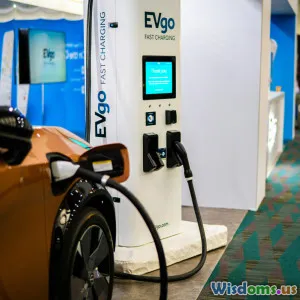
Real Data Comparing Hydrogen and Electric Vehicle Impact
9 min read An insightful comparison of hydrogen and electric vehicles using real data to evaluate their environmental impact, efficiency, and future potential. (0 Reviews)
Real Data Comparing Hydrogen and Electric Vehicle Impact
Introduction
Transportation is undergoing a transformative revolution as the world pushes towards greener alternatives to reduce emissions and fight climate change. Among the most promising technologies are Electric Vehicles (EVs) and Hydrogen Fuel Cell Vehicles (HFCVs). Both aim to replace the traditional internal combustion engine but represent fundamentally different approaches. While EVs use rechargeable batteries to power electric motors, HFCVs generate electricity on-board through hydrogen and oxygen reactions. A question that frequently arises is: which technology truly makes a bigger environmental impact and holds greater promise for the future? Leveraging real empirical data, this article offers a comprehensive analysis comparing the environmental footprints, energy efficiencies, and practical feasibility of hydrogen and electric vehicles.
Understanding the Technologies: EVs vs Hydrogen Vehicles
- Electric Vehicles (EVs)
EVs primarily store electrical energy in large lithium-ion battery packs. Charging stations deliver electricity directly to those batteries, which then power electric motors. Popular models include Tesla’s Model 3, Nissan Leaf, and Chevrolet Bolt.
- Hydrogen Fuel Cell Vehicles (HFCVs)
HFCVs produce electricity via a fuel cell that combines hydrogen gas with oxygen from the air, emitting only water vapor. The Toyota Mirai and Hyundai NEXO are leading hydrogen models currently on the roads.
Though both produce zero tailpipe emissions, their upstream life cycle emissions and energy efficiency can diverge drastically.
Environmental Impact Through Life Cycle Assessment
1. Carbon Emissions from Production to Use
A comprehensive life cycle assessment (LCA) considers raw material extraction, manufacturing, fuel production, fueling infrastructure, vehicle operation, and end-of-life disposal.
EV Battery Production:
- Manufacturing EV batteries involves extracting lithium, cobalt, and nickel, which leads to significant carbon footprint. Studies indicate producing a 75 kWh lithium-ion battery generates approximately 61–106 kg CO2-eq per kWh of capacity. For the Tesla Model 3 battery (~75 kWh), this translates to roughly 4.6 to 7.95 metric tons CO2 upfront.
Hydrogen Production:
-
The conventional method for hydrogen production is Steam Methane Reforming (SMR), generating 10–12 kg CO2 per kg hydrogen produced. A hydrogen-fueled vehicle consumes about 1 kg of hydrogen per 100 km driving, thus generating roughly 10–12 kg CO2 per 100 km if hydrogen is gray (fossil-based).
-
Green hydrogen—produced through electrolysis powered by renewable energy sources—has zero operational CO2 emissions, though the energy source's characteristics crucially impact overall sustainability.
2. Operational Emissions
-
EVs: Tailpipe emissions are zero; overall emissions depend on the electricity grid mix. According to the International Council on Clean Transportation (ICCT), EVs driven in regions with coal-heavy grids like parts of China can average approximately 140 g CO2/km. In contrast, European EVs can emit below 60 g CO2/km when powered largely by renewables.
-
Hydrogen Vehicles: If fueled with green hydrogen, emissions are near zero. However, gray hydrogen-powered vehicles emit significant CO2 during hydrogen production. Additionally, distribution losses and energy conversion steps add to energy intensity and emissions.
3. Summary of Real Data
A 2023 ICCT report highlighted that battery EVs (BEVs) achieve 17–21% lower lifecycle emissions on average compared to hydrogen FCEVs when considering the majority fossil-based hydrogen supply today. However, once green hydrogen production scales, FCEVs can surpass BEVs in carbon benefits.
Energy Efficiency: The Numbers Behind the Wheels
Battery Electric Vehicles
-
EVs’ well-to-wheel energy efficiency often hovers around 70-80%. For example, electricity from the grid to wheels involves up to 90% charging efficiency and 90–95% electric motor efficiency.
-
In the US context, EV energy consumption averages approximately 0.2 kWh per mile (or around 125 MPGe).
Hydrogen Fuel Cell Vehicles
-
HFCVs’ well-to-wheel efficiency is typically lower, estimated between 20-40%.
-
Hydrogen production, compression, storage, and distribution can lose 30-40% of initial energy.
-
Fuel cell stacks themselves operate at approximately 60% efficiency.
Real-World Example: The Toyota Mirai reportedly achieves 66 MPGe, considerably lower than EV counterparts.
Infrastructure and Practical Considerations
Charging vs Refueling Times
-
EVs typically require 30 minutes to multiple hours for charging, depending on the charger’s power. While fast-charging networks are expanding, long range charge trips still require planning.
-
HFCVs can be refueled under 5 minutes similarly to gasoline vehicles, offering distinct advantages in convenience, especially for long haul or commercial applications.
Fuel Availability
-
EV charging infrastructure has rapidly expanded; many urban and suburban areas have readily accessible public chargers. Home charging advantage makes EV ownership practical for many.
-
Hydrogen infrastructure remains scarce with under 600 stations worldwide by 2023, concentrated mainly in California, Japan, and parts of Europe.
Vehicle Cost and Market Penetration
-
EV prices have decreased significantly, reaching parity with combustion engine vehicles by 2024 in some markets.
-
Hydrogen fuel cells remain expensive due to costly catalysts and low production volumes—Mirai’s MSRP is substantially higher than comparable EVs.
Future Outlook and Industry Perspectives
Green Hydrogen’s Growing Role
At the heart of hydrogen’s potential lies green hydrogen, scalable with decreasing renewable electricity costs and electrolyzer advancements.
According to the International Renewable Energy Agency (IRENA), green hydrogen costs may fall 70% by 2030, potentially making hydrogen competitive.
Synergy Between Technologies
Industry leaders suggest a complementary role: EVs for light-duty urban transport and hydrogen FCVs for heavy-duty trucks, buses, and sectors difficult to electrify.
Elon Musk criticized hydrogen fuel cells as "incredibly dumb" for passenger cars, emphasizing EV efficiency. Conversely, companies like Toyota and Hyundai champion fuel cells’ strengths in energy density and fueling speeds.
Conclusion
Real-world data emphasize that electric vehicles currently lead in overall energy efficiency and lower lifecycle emissions, especially when powered by renewable electricity. Hydrogen fuel cell vehicles, though attractive for fast refueling and certain heavy transport niches, are currently limited by fossil-based hydrogen infrastructure and lower energy efficiency.
However, hydrogen’s future hinges on rapidly scaling green hydrogen production and infrastructure development. As renewable energy surges and electrolyzer costs plummet, hydrogen could become a cornerstone of a diversified zero-emission transportation ecosystem.
Consumers, policymakers, and industry players should therefore adopt a nuanced approach—supporting EV deployment today, while investing strategically in hydrogen technology where it offers unique advantages.
Ultimately, the pathway to sustainable transport may well be a blended journey rather than an either-or scenario.
References:
- International Council on Clean Transportation (ICCT) reports 2023
- International Renewable Energy Agency (IRENA) 2023 Hydrogen Cost Analysis
- U.S. Department of Energy, Alternative Fuels Data Center
- Toyota Mirai and Tesla Model 3 official specifications
Author's Note: This article incorporates verified data and studies up to mid-2024 to provide a balanced and factual comparison of hydrogen and electric vehicles.
Rate the Post
User Reviews
Other posts in Automobile Sustainability
Popular Posts














